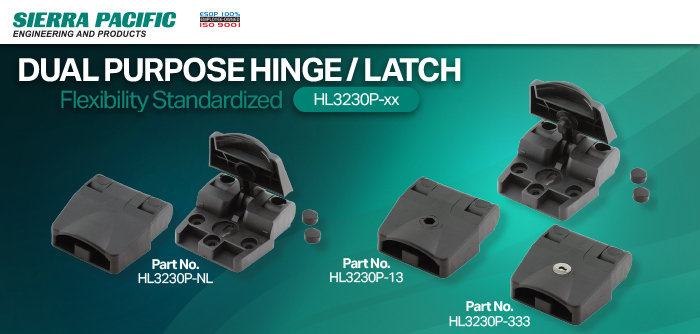
Magnetic door latches are foundational pieces of access hardware in the industrial setting. They provide an efficient means of securing enclosures, doors, and cabinets while also allowing effortless one-hand operation, promoting safety and accessibility.
In this blog, we’ll explore how magnetic door latches work, what benefits they provide, and common applications. By familiarizing yourself with this widely used access hardware component, you can determine whether it is the right choice for your project or design.
Magnetic Latch vs. Magnetic Door Catch
We often use the terms “magnetic door latch” and “magnetic door catch” interchangeably, as both refer to mechanisms that utilize magnetism to secure doors. However, there can be some subtle differences between them. A magnetic door latch typically refers to the complete hardware assembly, compromising both the magnetized component (the latch) and the ferrous metal plate (the strike plate) to which it attaches to. When the door closes, the magnetized latch contracts the strike plate and secures the door in place.
On the other hand, a magnetic door catch may refer specifically to the magnetized component without including the strike plate. In this case, the catch attaches to a ferrous metal surface on the door frame or an adjacent surface. As the door closes, the catch and metal surface forms a magnetic connection that keeps the door shut. To clarify, the key difference lies specifically in the components referenced by each term. A magnetic door latch typically includes both parts of the mechanism, whereas a catch may refer solely to the magnetized part. As stated above, we will refer to the complex mechanism, not just the catch.
What Is a Magnetic Door Latch?
A magnetic door latch is a piece of access hardware designed to secure doors, cabinets, or enclosures using the power of magnetism. It has two main parts: a magnetized catch and a ferrous metal plate.
These pieces of hardware are known for their simplicity, reliability, and ease of use. You don’t have to manually activate or deactivate a lock. Instead, pushing an enclosure shut will engage the magnetic forces. Conversely, pulling or pushing it open will disengage the magnetic pull.
Thanks to this simplicity, these components require virtually no maintenance. Unless misused, they can offer years of reliable service and performance. They are also incredibly easy to install, as you only have to align and mount two pieces of hardware, neither of which contains internal mechanisms or complex moving parts.
How Magnetic Latches Work
Consider, for a moment, a scenario in which you walk up to a door secured with a magnetic latch. As you push or pull the door to open it, the magnetic catch releases its hold on the plate, allowing the door to swing freely. Once you close the door, the magnetism re-engages, securing the entranceway or enclosure. As you close the door, the catch holds onto the plate. This creates a secure lock and holds the door in place. As you push or pull it open, you will overcome the power of the magnet.
One of the biggest advantages of these mechanisms is their simplicity. They require almost no maintenance, are easy to install, and can be operated with just one hand. If you are making your way through a push door and have your hands full, you can simply lean into the entrance to disengage the lock.
Typical Industrial Magnetic Latch Uses and Applications
It’s possible to integrate magnetic door latches into all sorts of projects and designs in the industrial setting. For instance, manufacturing clients often use these pieces of hardware to secure access panels on machinery, which facilitates maintenance tasks while also meeting important safety protocols.
Additionally, you can install magnetic latches on cabinets or enclosures housing important equipment or materials. These devices promote easy access to important work resources and ensure that the enclosure remains secure when not in use. Magnetic access hardware has become quite popular in the automotive setting as well. Numerous designers have used these solutions to secure glove boxes and tool compartments. By doing so, manufacturers provide consumers with exceptional convenience. Magnetic access hardware can also improve safety by guaranteeing that the enclosures will stay shut while the vehicle is in motion.
The aerospace industry has also adopted magnetic door catches. Stakeholders in this sector use these components to create corrosion-resistant hardware for access panels and hatches in demanding environments. Marine equipment manufacturers favor magnetic hardware for similar reasons.
Why Should You Use a Magnetic Door Latch?
If you are in the market for a reliable, convenient, and low-maintenance access hardware solution for your project or design, magnetic door latches may be the ideal solution. They are also cost-effective and easy to install, which makes them a viable option to implement at scale.
Despite the advantages of magnetic latches, they are not one-size-fits-all access hardware solutions. Fortunately, Sierra Pacific Engineering and Products (SPEP) has an extensive line of access hardware available for your project needs. Our team can help you identify the best type of latching or locking mechanism for your intended use case. We will work to ensure exceptional fit, function, and performance.
If you would like to learn more about our magnetic latches or need assistance determining the right type of access hardware for your project, connect with SPEP. We will be happy to assist you and even offer custom design services.
Editor’s Picks

Sierra Pacific Engineering College Scholarship Program
Feb 7, 2022

What is Supply Chain Management, and Why Is It Important?
Jan 13, 2022

How To Make Threads in Solidworks: Become a Solidworks Expert
Nov 10, 2020






